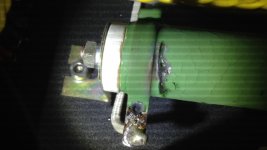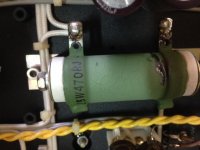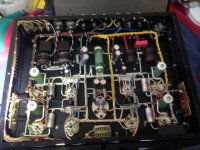Yeah, I know, people from Aruba are much more relaxed than those in NL
I should learn from you.
Jan
Ik ben zo'n15 jaar geleden verhuist hierheen dus ik snap het helemaal! Bedankt voor het meedenken zover
Jock
Jo, så brukar vi också göra när vi fiskar kräftor.Ik ben zo'n15 jaar geleden verhuist hierheen dus ik snap het helemaal! Bedankt voor het meedenken zover
Jock
Jo, så brukar vi också göra när vi fiskar kräftor.
We'll I did own a Askeladden 635 Walkaround boat but that was made in Norway I think
When made properly no matter how many connection it has. The example is, a good sound console, with multiple inputs and outputs. No dirty currents through ground loops = no hum.
A multi amped set up has more ground connections, which increases the odds of creating a loop. My system has 4 stereo amps, plus a self powered sub, a crossover/pre, phono amp, and headphone amp. Zero hum. But I can get hum if I plug things in haphazardly. Approaching it is like grounding the internal amp connections. You can use a star approach, or a buss. Most important is that all grounds go to a single outlet box for the mains. How about a diagram of your ground connections?
Sheldon
A multi amped set up has more ground connections, which increases the odds of creating a loop. My system has 4 stereo amps, plus a self powered sub, a crossover/pre, phono amp, and headphone amp. Zero hum. But I can get hum if I plug things in haphazardly. Approaching it is like grounding the internal amp connections. You can use a star approach, or a buss. Most important is that all grounds go to a single outlet box for the mains. How about a diagram of your ground connections?
When I used a HP notebook with external I/O interface to record live concert from console through unbalanced outs I had to power the charger through an isolation transformer.
Usual source of ground loop noise through interconnect is the result of power filters with Y-caps that do harm when not needed to pass certifications. But in this topic the source of the hum is the amp itself, it is a different story.
Here's a small update.
I started with the easiest, plugging them all in the same group. Result was stil hum.
Then while listening to music a pop, onze tube lit up and then smoke from the bottom of the amp............
Hopefully I can find the time tomorrow to open it up and see what has happened.
Pfffff here's a challenge Aruba is great fun to live but not when these things happen
I started with the easiest, plugging them all in the same group. Result was stil hum.
Then while listening to music a pop, onze tube lit up and then smoke from the bottom of the amp............
Hopefully I can find the time tomorrow to open it up and see what has happened.
Pfffff here's a challenge Aruba is great fun to live but not when these things happen
Hi,
I opened the amp up and I think I found the part that smoked. Some sort of a resistor maybe?
Can anybody help me with fixing this?
If I can order this part or similar I'll be able to do the soldering. Other than that I have no knowledge when it comes to electronics, maybe there are other components I'll need to check now?
Thank you Jock
I opened the amp up and I think I found the part that smoked. Some sort of a resistor maybe?
Can anybody help me with fixing this?
If I can order this part or similar I'll be able to do the soldering. Other than that I have no knowledge when it comes to electronics, maybe there are other components I'll need to check now?
Thank you Jock
Attachments
Here's a small update.
I started with the easiest, plugging them all in the same group. Result was stil hum.
Did you plug them in one at the time and noted at which point the hum started?
Jan
Did you plug them in one at the time and noted at which point the hum started?
Jan
No Jan,I didn't. That can be something to try next time. But first I need to repair the amp that died yesterday, see previous two posts
Thanks
it's a big power resistor.
looks like the 15W is the power in Watts
The 470r is the resistance in ohms
and the J is tolerance ±5%
Thanks Andrew, I checked and is says 25W.
Can I just look for another with these specs or are there additional audio related thinks to also look out for?
Jock
Last edited:
that tiny resistor needs a big heatsink to dissipate the heat.
Hi Andrew,
That doesn't sound encouraging. Any suggestions what to get? I can have the part to the Netherlands also.
Thank you,
Jock
If the chassis is aluminum, you can attach it directly to the chassis with thermal grease. If it's steel, attach it to a piece of 3mm thick or so aluminum (or copper), then attach that to the chassis (both attachments with thermal grease). Make the aluminum spreader as big as you can fit without touching any circuit contact points.
Sheldon
Sheldon
The ones you linked to are fine - even without much heat sinking. Their operating max temperature, if I read the specs correctly, is 350 degrees C. You only need to keep it well below the melt temp of your solder (183 Degrees for eutectic Sn/Pb, 220 degrees for Sn/Ag ). If you want to use the same mounting holes as the current units, you'd have to fabricate a little bracket anyway.
I suspect that will be a whole lot easier than finding duplicates of the original part (which failed anyway).
Sheldon
I suspect that will be a whole lot easier than finding duplicates of the original part (which failed anyway).
Sheldon
Another thought: You have 4 electrolytic caps close to that resistor. It would be good to know how hot it gets in that area. A multimeter with a temperature probe would be useful here. If it were my amp, I'd want those caps are working-life rated at 105degrees - to be on the safe side. Were I building that amp, and that resistor gets hot, I'd either vent the area above that resistor, or mount the resistor top-side (with careful insulation of the leads, so no exposed conductors).
Sheldon
Sheldon
- Status
- This old topic is closed. If you want to reopen this topic, contact a moderator using the "Report Post" button.
- Home
- Amplifiers
- Tubes / Valves
- Hum when ground connected


